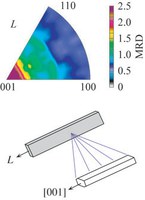Hydroxyapatite Whisker Reinforced Biocomposites for Synthetic Bone Substitutes
Funding: Indiana 21st Century Fund and the U.S. Army Medical Research and Materiel Command
Graduate Students: Gabriel L. Converse, Robert J. Kane and Timothy Conrad
Undergraduate Intern: John Souder
Collaborators: JoEllen Welsh, Ph.D. (Biological Sciences, Notre Dame) and Stephen Smith, M.D. (North Central Neurosurgery, South Bend, IN)

 In order to meet the challenges of the next century, new synthetic biomaterials must be developed that are able to interact synergistically with natural tissues and biological processes. The extracellular matrix of bone tissue is a collagen matrix reinforced with apatite mineral crystals that have an elongated c-axis and exhibit a preferred orientation along directions of principle stress. Hydroxyapatite (HA) is the closest synthetic equivalent to human bone mineral, and is biocompatible and bioactive in vivo. The overall objective of this project is to investigate processing-structure-property relationships in HA whisker reinforced biocomposites in order to mimic salient aspects of the structure and biomechanical function of human bone tissue. For example, HA whisker reinforced polyetheretherketone (PEEK) has been tailored to mimic the elastic moduli, ultimate tensile strength and anisotropy of human cortical bone. The fatigue life of HA whisker reinforced high density polyethylene (HDPE) was shown to be 4-5 times longer than that for conventional powder reinforcement. Micromechanical models are being developed to relate the effects of the reinforcement morphology, orientation, and volume fraction to the mechanical properties. The in vitro response of osteoblasts to HA whisker reinforced biomaterials is also being investigated with collaborators in Biological Sciences. In vivo studies in small animal models are planned in collaboration with a local surgeon.
In order to meet the challenges of the next century, new synthetic biomaterials must be developed that are able to interact synergistically with natural tissues and biological processes. The extracellular matrix of bone tissue is a collagen matrix reinforced with apatite mineral crystals that have an elongated c-axis and exhibit a preferred orientation along directions of principle stress. Hydroxyapatite (HA) is the closest synthetic equivalent to human bone mineral, and is biocompatible and bioactive in vivo. The overall objective of this project is to investigate processing-structure-property relationships in HA whisker reinforced biocomposites in order to mimic salient aspects of the structure and biomechanical function of human bone tissue. For example, HA whisker reinforced polyetheretherketone (PEEK) has been tailored to mimic the elastic moduli, ultimate tensile strength and anisotropy of human cortical bone. The fatigue life of HA whisker reinforced high density polyethylene (HDPE) was shown to be 4-5 times longer than that for conventional powder reinforcement. Micromechanical models are being developed to relate the effects of the reinforcement morphology, orientation, and volume fraction to the mechanical properties. The in vitro response of osteoblasts to HA whisker reinforced biomaterials is also being investigated with collaborators in Biological Sciences. In vivo studies in small animal models are planned in collaboration with a local surgeon.



